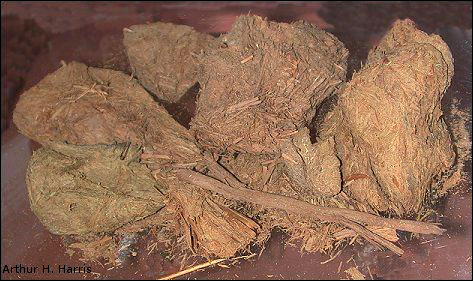 Learning Links:
Learning Links:  Facilitators
Facilitators  Learners
Learners 

"Scat" doesn't always mean "shoo". Generally avoided by normal people, animal scat, which refers to digestive waste or feces, receives its share of biological research. Most people consider it offensive, but droppings contain a world of information for the scientist. For example, by studying scat, they can identify the animal it came from and estimate the size of a population in the area. Close examination, usually microscopic, may reveal the animal's diet along with remains or eggs of its internal parasites.
Study is not limited to the feces of modern animals. In our own Chihuahuan Desert area, fossil dung of the Shasta ground sloth has been recovered from deposits in dry caves, revealing details of meals eaten over 10,000 years ago.
An example of mammoth scat is on display at the Centennial Museum.

Listen to the Audio (mp3 format) as recorded by KTEP, Public Radio for the Southwest.
Contributor: Arthur H. Harris, Laboratory for Environmental Biology, University of Texas at El Paso.
Desert Diary is a joint production of the Centennial Museum and KTEP National Public Radio, University of Texas at El Paso.

Mammoth scat on display at the Centennial Museum. On loan through the courtesy of the National Park Service. Mammoths and mastodons ate plant matter. By studying these excreted dried remains, scientists can determine what plants the animals ate and infer what the environment was like when these ice-age animals were alive. These are fragments of a bolus (excreted dropping). Complete boluses found in caves have measured 9 X 7 X 3.3 inches, similar to boluses produced by African elephants.
Anonymous. October, 1993. Geographica: Mastodon's Gourd Meals Dash Dispersal Theory. National Geographic Magazine.
Davis, O. K. 1984. The Pleistocene Dung Blanket of Bechan Cave, Utah. Pp. 267-282, in Contributions in Quaternary Vertebrate Paleontology: A Volume in Memorial to John E. Guilday. Carnegie Museum of Natural History, Special Publication No. 8, 538 pp.
Dewey, J. O. 1991. A Coloring Book of Prehistoric Walkers of the Southwest. Museum of New Mexico Press, Santa Fe.